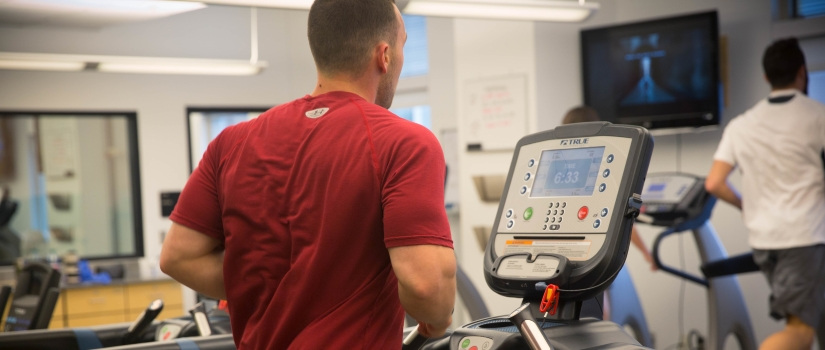May 10, 2017 | Erin Bluvas, bluvase@sc.edu
In addition to housing the No. 1 Ph.D. program (Exercise Science) in the country, the Department of Exercise Science is also home to popular master’s and bachelor’s programs and an array of research laboratories and centers. Faculty, staff, and students within the department are on the forefront of building the body of knowledge concerned with the relationship between physical activity and human health.
To maximize the depth and breadth of opportunities for engaging in exercise science research, the Clinical Exercise Research Center (CERC) was established when the department moved in to the Public Health Research Center building over ten years ago. Located on the third floor of the Public Health Research Center (921 Assembly Street), CERC is designed to support Arnold School of Public Health faculty and student research and clinical activities simultaneously—spanning large, grant-funded projects to clinical assessments. In the last five years, a dozen major projects with more than a thousand participants have used CERC facilities to conduct cutting edge research.
The Center’s state-of-the-art equipment allows for precise measurement of metabolic and cardiorespiratory responses and adaptations to exercise. The facilities include a full range of weight training equipment as well as aerobic equipment.
Among its many capabilities, CERC equipment allows for assessment of cardiorespiratory fitness (see Arnold School story on the importance of this measurement as a standard clinical vital sign) by measuring active and resting respiratory consumption and metabolic rate. Cardiac activity is monitored using an electrocardiogram. They also have a phlebotomy room where blood is collected, processed, and stored. The department’s Exercise Biochemistry Laboratory has the capacity to analyze stored samples for lipids, glucose, metabolic hormones, cytokines, inflammatory markers, indicators of appetite and hunger, and others.
One of the unique features of CERC is the climate-controlled Environmental Chamber that allows researchers to study how heat and humidity affect individuals as they engage in physical activity. This area of research is important for the safety and well-being of athletes and others who exercise during warm weather. Another key piece of equipment is the Dual Energy X-ray Absorptiometry (DEXA) machine, which is used to measure body composition and bone density. This gold standard in body composition equipment uses a full or partial body scans to measure fat mass, fat free mass, visceral adiposity, and bone mineral density.
“Most people are familiar with basic anthropometrics like height, weight, BMI and estimates of body fat with calipers or bioelectrical impedance,” says CERC Director Sarah Schumacher. “While we offer those services in our facility, we also have a DEXA scanner which allows us get a much more comprehensive look at total body composition. In addition to fat just below the skin, the image from a DEXA scan shows fat around the organs. It is this visceral adiposity that can increase an individual’s risk for many adverse health conditions, making this measurement an advantage over those that simply estimate subcutaneous fat.”
CERC also has a Biodex System 3 that measures muscular strength and range of motion. Clinicians and researchers, such as those in the department’s Doctor of Physical Therapy and Athletic Training programs, use this piece of equipment to look at patients’ rehabilitation progress after injuries.
The best part about CERC is that it this comprehensive, technological advanced Center is available to students and researchers across the university and clinicians and individuals from the community. From research projects and clinicians looking for sophisticated assessment tools to exercise groups and individual athletes, CERC facilities can be utilized to advance public health in numerous ways.
For a full list of services and more information about CERC, visit the Center’s website or contact Sarah Schumacher at dickeysc@mailbox.sc.edu or 803-777-3331.
